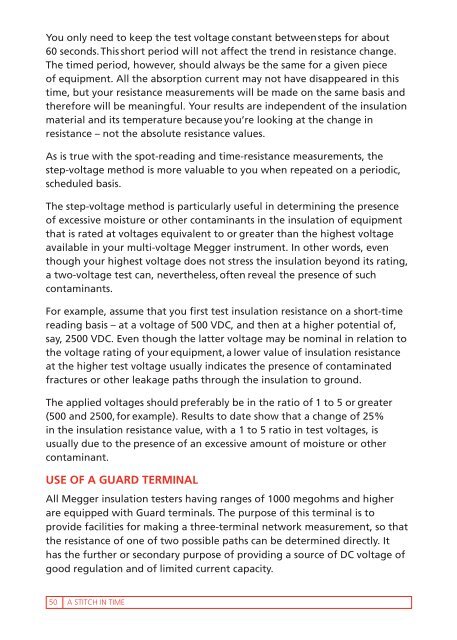“A Stitch in Time...”
You also want an ePaper? Increase the reach of your titles
YUMPU automatically turns print PDFs into web optimized ePapers that Google loves.
You only need to keep the test voltage constant between steps for about<br />
60 seconds. This short period will not affect the trend <strong>in</strong> resistance change.<br />
The timed period, however, should always be the same for a given piece<br />
of equipment. All the absorption current may not have disappeared <strong>in</strong> this<br />
time, but your resistance measurements will be made on the same basis and<br />
therefore will be mean<strong>in</strong>gful. Your results are <strong>in</strong>dependent of the <strong>in</strong>sulation<br />
material and its temperature because you’re look<strong>in</strong>g at the change <strong>in</strong><br />
resistance – not the absolute resistance values.<br />
As is true with the spot-read<strong>in</strong>g and time-resistance measurements, the<br />
step-voltage method is more valuable to you when repeated on a periodic,<br />
scheduled basis.<br />
The step-voltage method is particularly useful <strong>in</strong> determ<strong>in</strong><strong>in</strong>g the presence<br />
of excessive moisture or other contam<strong>in</strong>ants <strong>in</strong> the <strong>in</strong>sulation of equipment<br />
that is rated at voltages equivalent to or greater than the highest voltage<br />
available <strong>in</strong> your multi-voltage Megger <strong>in</strong>strument. In other words, even<br />
though your highest voltage does not stress the <strong>in</strong>sulation beyond its rat<strong>in</strong>g,<br />
a two-voltage test can, nevertheless, often reveal the presence of such<br />
contam<strong>in</strong>ants.<br />
For example, assume that you first test <strong>in</strong>sulation resistance on a short-time<br />
read<strong>in</strong>g basis – at a voltage of 500 VDC, and then at a higher potential of,<br />
say, 2500 VDC. Even though the latter voltage may be nom<strong>in</strong>al <strong>in</strong> relation to<br />
the voltage rat<strong>in</strong>g of your equipment, a lower value of <strong>in</strong>sulation resistance<br />
at the higher test voltage usually <strong>in</strong>dicates the presence of contam<strong>in</strong>ated<br />
fractures or other leakage paths through the <strong>in</strong>sulation to ground.<br />
The applied voltages should preferably be <strong>in</strong> the ratio of 1 to 5 or greater<br />
(500 and 2500, for example). Results to date show that a change of 25%<br />
<strong>in</strong> the <strong>in</strong>sulation resistance value, with a 1 to 5 ratio <strong>in</strong> test voltages, is<br />
usually due to the presence of an excessive amount of moisture or other<br />
contam<strong>in</strong>ant.<br />
Use of a Guard Term<strong>in</strong>al<br />
All Megger <strong>in</strong>sulation testers hav<strong>in</strong>g ranges of 1000 megohms and higher<br />
are equipped with Guard term<strong>in</strong>als. The purpose of this term<strong>in</strong>al is to<br />
provide facilities for mak<strong>in</strong>g a three-term<strong>in</strong>al network measurement, so that<br />
the resistance of one of two possible paths can be determ<strong>in</strong>ed directly. It<br />
has the further or secondary purpose of provid<strong>in</strong>g a source of DC voltage of<br />
good regulation and of limited current capacity.<br />
50<br />
A STITCH IN TIME



